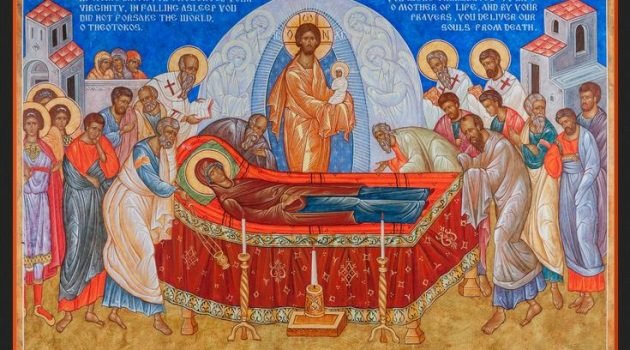Dormition of the Mother of God
On this coming Friday our Church celebrates the feast of the Dormition of the Mother of God (Our communal celebration of the feast will be on the weekend when we will bless flowers). This feast is one of the twelve major of our Church. It is also called the Falling Asleep of the Mother of God.
The celebration of this feast came into practice by way of custom and not Church legislation. As with the nativity of the Virgin and the feast of her entrance to the temple, there are no biblical or historical sources for this feast. The Tradition of the Church is that Mary died as all people die, not “voluntarily” as her Son, but by the necessity of her mortal human nature which is indivisibly bound up with the corruption of this world. The first four centuries are silent regarding the end of Mary’s life, though it is asserted, without surviving documentation, that this feast was observed in Jerusalem shortly after the Council of Ephesus (431). Earliest Dormition traditions surfaced in the later 5th century when three distinct narrative traditions dealing with the end of Mary’s life appeared. These narratives are characterized as the Palm of the Tree of Life narrative, the Bethlehem narrative, and the Coptic narrative. There are also a handful of other, atypical narratives.
The Dormition tradition is associated with various places: notably Jerusalem, which contains Mary’s Tomb and the Basilica of the Dormition, Ephesus, which contains the House of the Virgin Mary and Constantinople where the Cincture of the Mother of God was enshrined from the 5th – 14th centuries.
Although the Orthodox Church celebrates this feast as a part of tradition, it does not assert that this is dogmatically true. Pope Pius XII declared this a dogma in 1950. Since the entire Church was not involved in this declaration, the Orthodox Church does not accept it as dogma but, in essence, celebrates it as a part of Christian tradition.
The foundation for this feast is to be found in a sacred tradition of the Church dating from apostolic times, apocryphal writings, the constant faith of the People of God, and the unanimous opinion of the holy Fathers and Doctors of the Church of the first thousand years of Christianity. The earliest written tradition in the East, which speaks of the death of the Mother of God, has the title Sermon of St. John the Theologian on the Dormition of the Mother of God. The author of this work is unknown. Some historians believe this work dates from the end of the second/third century, while others place it at the end of the sixth century. To this day historians cannot prove anything certain about the place of her burial.

